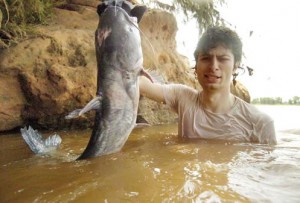An Introduction To Noodling
At its most basic level, noodling is a skill that consists of an angler’s catching catfish with his bare hands. It is of Native American origin and is usually passed down from father to son.
Noodling is known by many names, including dogging, grabbling and gurgling, and the process comprises an angler attempting to catch a catfish by standing in the water over its nest or hole and then slowing lowering his hands until they are just inside it the hole. The catfish, if it is in the hole at the time, will react either by trying to swim away - and the angler would then grab it by the gills - or, more commonly, by defensively biting and latching onto the angler’s hands. As soon as the angler has a grip on the catfish - or the catfish on the angler - the angler either pulls the catfish to the shore or, if the hole is quite deep, swims to the surface holding the catfish and then gives it to his assistant, who is called a spotter, to secure it.
The flathead catfish, or yellow cat as it is also called, is the noodler’s main target although both other types of catfish and other types of fish can be caught this way. Catfish lend themselves to noodling, however, as they live in sheltered holes that are under submerged plants, logs or other water-based debris, and are thus easy to trap. They are found in rivers of all shapes and sizes and also in reservoirs, and their holes are found at depths of between a few and twenty feet. Catfish weighing up to 60 pounds have been caught by noodling but, at these sizes, the fish are rather difficult to subdue. Noodlers have also been known to construct special boxes to place over the catfish holes before attempting the snatch to try to make cornering the fish that little bit easier.
Noodling is practiced throughout the world and some countries even hold competitions like the Argungu Fishing Festival which is hosted by Nigeria. Canada is also presently experimenting with noodling as a possible economic alternative to other fish catching methods, although Goldeye fish, and not catfish, are the intended target. In the USA, noodling appears to be most prevalent in Oklahoma, where the Annual Okie Noodling Tournaments are held. Laws governing noodling differ from state to state, however, and noodling is a phenomenon seen mostly in southern states simply because it is illegal in most northern states. Noodling is, in fact, legal in only eleven states: Oklahoma, Kansas, Georgia, Illinois, Alabama, Arkansas, Tennessee, Mississippi, Kentury, Louisiana and Missouri.
No-one should attempt noodling without first acquiring some training in the sport as there are several dangers inherent in the practice. Many noodlers are missing fingers or toes from those times when over enthusiastic catfish have won the day but the pastime also offers more serious dangers especially if catfish holes are far underwater and an angler could drown if injured by a feisty catfish or his clothing gets snagged. Other creatures like snakes or snapping turtles may also have taken up residence in an abandoned catfish hole, but a noodler would not find this out until he reaches inside. In these instances, it would be best to work with a spotter as, not only do they take care of the catfish that have been caught, they can also take care of an injured noodler or at least call someone who can.
Noodling, or to use some of its more exotic names, hogging, catfisting or stumping, can also to refer to any unconventional method of fishing where bait, a rod, a reel or other equipment is not used as well as to any type of handfishing. This alternative use of the term is rare, though, and whenever noodling is mentioned, chances are that the parties are discussing handfishing for catfish.
Noodling is not widely practiced but is constantly growing in popularity and, in some areas, has even been classified as an extreme sport. For an angler, however, noodling is definitively a skill worth having as many a fat catfish would still be swimming around today if fewer fishermen knew how to noodle.

